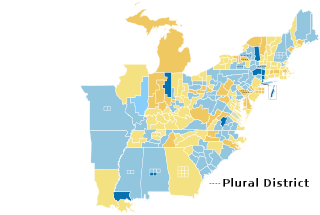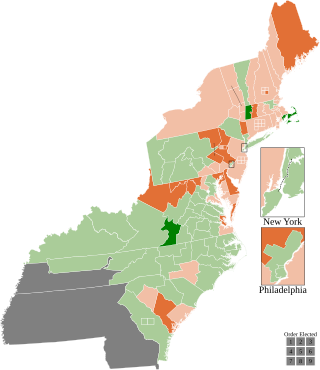Related Research Articles

The 1952 United States Senate elections was an election for the United States Senate which coincided with the election of Dwight D. Eisenhower to the presidency by a large margin. The 32 Senate seats of Class 1 were contested in regular elections, and three special elections were held to fill vacancies. The Republicans took control of the Senate by managing to make a net gain of two seats. However, Wayne Morse (R-OR) became an independent forcing Republicans to rely on Vice President Richard Nixon's tie-breaking vote, although Republicans maintained a 48–47–1 plurality. Wayne Morse would caucus with the Republicans at the start of Congress’ second session on January 6, 1954 to allow the GOP to remain in control of the Senate. This was the third time, as well as second consecutive, in which a sitting Senate leader lost his seat.

The 1946 United States Senate elections were held November 5, 1946, in the middle of Democratic President Harry S. Truman's first term after Roosevelt's passing. The 32 seats of Class 1 were contested in regular elections, and four special elections were held to fill vacancies. The Republicans took control of the Senate by picking up twelve seats, mostly from the Democrats. This was the first time since 1932 that the Republicans had held the Senate, recovering from a low of 16 seats following the 1936 Senate elections.

1916 United States House of Representatives elections were elections for the United States House of Representatives to elect members to serve in the 65th United States Congress. They were held for the most part on November 7, 1916, while Maine held theirs on September 11. They coincided with the re-election of President Woodrow Wilson.
The 1850–51 United States House of Representatives elections were held on various dates in various states between August 5, 1850, and November 4, 1851. Each state set its own date for its elections to the House of Representatives before the first session of the 32nd United States Congress convened on December 1, 1851. Elections were held for all 233 seats, representing 31 states.
The 1848–49 United States House of Representatives elections were held on various dates in various states between August 1848 and November 1849. Each state set its own date for its elections to the House of Representatives before the first session of the 31st United States Congress convened on December 3, 1849. The new state of Wisconsin elected its first representatives, and California also held its first congressional elections before officially achieving statehood in 1850, increasing the size of the House to 233 seats.

The 1840–41 United States House of Representatives elections were held on various dates in various states between July 6, 1840, and November 2, 1841. Each state set its own date for its elections to the House of Representatives, before or after the first session of the 27th United States Congress convened on May 31, 1841. Elections were held for all 242 seats, representing 26 states.

The 1838–39 United States House of Representatives elections were held on various dates in various states between July 2, 1838, and November 5, 1839. Each state set its own date for its elections to the House of Representatives before the first session of the 26th United States Congress convened on December 2, 1839. They occurred during President Martin Van Buren's term. Elections were held for all 242 seats, representing 26 states.
The 1836–37 United States House of Representatives elections were held on various dates in various states between July 4, 1836, and November 7, 1837. Each state set its own date for its elections to the House of Representatives, either before or after the first session of the 25th United States Congress convened on September 4, 1837. With Arkansas and Michigan officially achieving statehood in 1836 and 1837, respectively, the size of the House was set at 242 seats.

The 1834–35 United States House of Representatives elections were held on various dates in various states between July 7, 1834, and November 5, 1835. Each state set its own date for its elections to the House of Representatives before the first session of the 24th United States Congress convened on December 7, 1835. They were held during President Andrew Jackson's second term. Elections were held for 240 seats that represented 24 states, as well as the at-large-district seat for the pending new state of Michigan.

The 1830–31 United States House of Representatives elections were held on various dates in various states between July 5, 1830, and October 3, 1831. Each state set its own date for its elections to the House of Representatives before the first session of the 22nd United States Congress convened on December 5, 1831. Elections were held for all 213 seats, representing 24 states.

The 1824–25 United States House of Representatives elections were held on various dates in various states between July 7, 1824, and August 30, 1825. Each state set its own date for its elections to the House of Representatives before the first session of the 19th United States Congress convened on December 5, 1825. Elections were held for all 213 seats, representing 24 states.

The 1800–01 United States House of Representatives elections were held on various dates in various states between April 29, 1800, and August 1, 1801. Each state set its own date for its elections to the House of Representatives before the first session of the 7th United States Congress convened on December 7, 1801. They were held at the same time as the 1800 presidential election, in which Vice President Thomas Jefferson, a Democratic Republican, defeated incumbent President John Adams, a Federalist. Elections were held for all 106 seats, representing 15 states.

The 1796–97 United States House of Representatives elections took place in the various states took place between August 12, 1796, and October 15, 1797. Each state set its own date for its elections to the House of Representatives. The size of the House increased to 106 seats after Tennessee became the 16th state to join the union. The first session of the 5th United States Congress was convened on May 15, 1797, at the proclamation of the new President of the United States, John Adams. Since Kentucky and Tennessee had not yet voted, they were unrepresented until the second session began on November 13, 1797.

The 1824–25 United States Senate Elections were held on various dates in various states. As these U.S. Senate elections were prior to the ratification of the Seventeenth Amendment in 1913, senators were chosen by state legislatures. Senators were elected over a wide range of time throughout 1824 and 1825, and a seat may have been filled months late or remained vacant due to legislative deadlock. In these elections, terms were up for the senators in Class 3.
A special election was held in Massachusetts's 1st congressional district on September 5, 1796, and November 21, 1796, to fill a vacancy caused by the resignation of Theodore Sedgwick (F) upon his election to the Senate
A special election was held in New Hampshire's at-large congressional district on August 25, 1800, to fill a vacancy left by William Gordon (F) resigning to accept an appointment as New Hampshire Attorney General on June 12, 1800.
A special election was held in Massachusetts's 4th congressional district on September 23, 1811, and November 4, 1811, to fill a vacancy left by the resignation of Joseph Bradley Varnum (DR) upon being elected to the Senate on June 29, 1811
A special election was held in Massachusetts's 10th congressional district on September 8, 1823, to fill a vacancy created by the resignation of William Eustis (DR) prior to the start of the 18th Congress.

A special election was held in Maine's 5th congressional district was held on September 11, 1826, to fill a vacancy caused by the resignation of Enoch Lincoln (A) in January, having been elected Governor of Maine. As a majority was not achieved on the first ballot, a second election was held November 27.
A special election was held in South Carolina's 1st congressional district on May 17, 1825, to fill a vacancy caused by the resignation of Joel R. Poinsett (J) on March 7, 1825 to become Minister to Mexico.